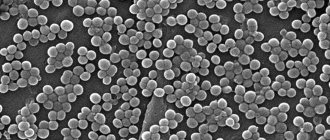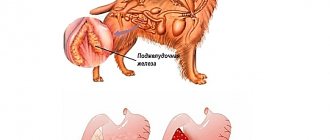Causes of the disease
The disease never occurs out of the blue; most often, asthmatic attacks in dogs are preceded by chronic bronchitis.
The following factors can trigger asthma:
- allergies to dust, pollen, food, insect bites;
- damage to mucous membranes through inhalation of toxic chemical fumes, smoke, exposure to sand and coarse dust;
- infections (bacteria, fungi, viruses);
- excessive physical activity;
- stressful conditions;
- unsatisfactory living conditions (dampness, drafts, etc.);
- climate change.
These reasons can be called primary, however, they are the mechanism that launches the process into action. Asthma is a very dangerous disease that requires long-term serious treatment; it does not go away on its own.
Treatment of the disease
Effective treatment of an animal is based on the following basic principles:
- Complete elimination of symptoms of the disease.
- Monitoring clinical manifestations of signs.
- Antigen control.
It is important for the owner to know that treatment for asthma continues for one to two months, despite the fact that all symptoms have been eliminated. This helps avoid relapses in the future.
Treatment is largely aimed at eliminating or mitigating the inflammatory processes that occur in the pet’s body. This is done using the following forms of pharmaceuticals:
- in tablets (Prednisolone, Metipred);
- inhalation (Fluticasone);
- injections (Dexamethasone).
To make the therapeutic effect even more intense, it is permissible to combine drugs aimed at combating inflammation with those that dilate the bronchi. You can also give your dog antihistamines (Suprastin), they reduce the animal’s sensitivity to certain types of allergens. A course of vitamins will be a good boost for a dog’s weakened body. If asthma is acute, it is recommended to use injections; if the condition has stabilized, gradually switch to inhalations or tablets.
To prevent relapse, a mandatory check-up with a veterinarian once every 6 months will be necessary. In addition, the owner must strictly limit the animal from contact with a potential allergen.
Main symptoms
An asthma attack develops in three stages - the early stage, the height, and the reverse stage.
The early stage is characterized by the following signs:
- change in breathing pattern (the dog puffs, breathes with its mouth open, makes wheezing and gurgling sounds);
- copious discharge of clear mucus from the nose;
- painful itching in the nose, eyes, perineum, paws;
- cough, sneezing;
- decreased appetite and physical activity;
- involuntary release of urine (during muscle spasms).
The height of asthma is the most dangerous. The dog mostly sits or stands with its paws spread wide. In this case, the mouth is open, the neck is extended, the back is hunched and tense, the ribs are straightened and can be easily felt, the skin in the sternum area is stretched. This position is explained by the body’s attempt to compensate for the oxygen deficiency by expanding the chest. In cases of loss of coordination or complete suffocation, the animal lies down.
Breathing is difficult for the dog and is accompanied by wheezing. Cyanosis of the mucous membranes indicates hypoxia. Also, the height of the fever is characterized by wetness of the wings of the nose, rapid heartbeat, cough with sputum production.
During the third stage, clinical signs of suffocation gradually disappear. The dog's condition returns to normal, but for several more days it remains lethargic, apathetic, weak and refuses walks and food.
Symptoms and treatment
Next, we will discuss the most striking symptoms of asthma in dogs and prescribe treatment.
Symptoms
- The most obvious symptom of an incipient asthma attack in dogs is a whistling sound when breathing. And it is not at all necessary that the attack will begin immediately. Sometimes it takes up to several hours, less often, but it still happens as long as days. However, only after hearing this characteristic whistle or squeak, it is necessary to act as prescribed by the veterinarian.
- Then the owner notices allergy symptoms: the nose and eyes are running, and the eyes are also itching wildly, coughing and sneezing. It is worth noting that most coughs are dry.
- If you look closely at how the animal breathes, you will notice that the inhalation is short and accompanied by abdominal cramps, and the exhalation is calm and slow. But extraneous sounds during breathing can be heard even without a phonendoscope at a great distance.
The dog is sitting, maybe trying to catch its breath. If one of the symptoms is spasms, the animal may involuntarily wet itself. For a dog, the most dangerous period is the initial period. The animal literally suffocates and may lose coordination. At this time, the pet can spread its paws wide, and the ribs can be in a straightened state. In this case, it will be noticeable how the skin on the chest tightens. If desired, you can feel the space between the ribs. The dog can also stretch its neck, hunch over, and open its mouth.
- A dangerous symptom of bronchial asthma in dogs is cyanosis (blue discoloration) of the mucous membranes.
Treatment
How to treat asthma in dogs? Treatment for bronchial asthma should always begin with identifying the cause of the attack.
First, go to the veterinarian and describe in great detail the symptoms of your pet's illness. This is necessary so that the doctor can prescribe treatment based on symptoms, experience and even intuition. After all, there is simply no specialized treatment for asthma for dogs. For example, if a dog’s bronchial asthma manifests itself against the background of a burn of the mucous membranes, partial pulmonary edema, pneumonia, etc., the veterinarian will prescribe a drug that relieves the symptomatic manifestations of asthma and treats the underlying ailment. Most often, treating the underlying cause leads to relief of asthma and no additional therapy is required.
If the cause of a dog's asthma is an allergic reaction, the triggering factor is first looked for. Until the allergen is eliminated, your dog's asthma will not go away.
To detect a potential allergen, the owner is advised to keep an “allergy diary” of the pet, where it is necessary to record the date and cause of the attack, its duration and possible allergens inhaled at that time.
The veterinarian will prescribe additional medications that will help the bronchi open again, which normalizes the breathing process. For this purpose, adrenergic agonists and bronchodilators are prescribed. Antihistamines also help (these are both anti-inflammatory and anti-allergenic). Corticosteroids may be prescribed.
- Inhaled (oral) steroids will prevent the development of inflammation. Prednisolone is popular in this regard, which can be administered intravenously in case of a severe attack.
- Antihistamines - restore airway patency, reducing the reaction to certain types of allergens.
- Bronchodilators – help expand the airways. This is achieved by spraying the medicine through a special spacer with a mask or by oral administration of Theophylline in a daily dose.
- Antibiotics - used in cases of exacerbation of the condition, if a secondary respiratory infection is confirmed.
- Oxygen masks are required if the dog is experiencing a particularly severe attack of suffocation, in which it is necessary to organize additional oxygen supply using a mask.
Diagnostics in a veterinary clinic
Asthma has similar symptoms to some respiratory pathologies, making it difficult to diagnose. The veterinarian conducts a comprehensive clinical examination, in which anamnesis plays an important role.
To obtain complete information, the following diagnostic studies are carried out:
- Auscultation, which allows you to evaluate the functioning of the bronchi and lungs and identify the localization of the inflammatory focus.
- blood tests (general, biochemical);
- urine analysis with identification of chemical indicators;
- stool analysis;
- cytology;
- tracheoscopy;
- bronchoscopy;
- chest x-ray;
- respiratory tract rinses;
- echocardiography or ultrasound examination of the heart.
Sometimes, even after a full examination, it is not possible to determine the factor that provokes the attacks. However, with good care and treatment, the dog continues to live a full life.
Diagnostics
There are several tests to determine whether a dog has lung disease.
- Minimum database (complete blood count, blood chemistry, fecal analysis and urine analysis). These tests will help assess the dog's overall health and may provide clues as to the underlying cause of the disease. One specific type of white blood cell, eosinophils, is commonly associated with allergic reactions and may indicate this disease. In addition, some dogs may require a heartworm test.
- Test for dirofilariasis (heartworms). This is not necessary for all dogs, as heartworms are rare in some parts of the country. However, in areas where the virus is spreading, even completely domestic dogs are at risk of infection.
- Chest X-ray. Characteristic changes in the lungs can be seen on x-rays. Additionally, in some cases, x-rays can reveal heartworms.
- Tracheal wash, cytology and lavage of the respiratory tract. Bronchoalverlar lavage is a procedure that allows the veterinarian to collect material from the lower airways. This material can be examined for the presence of microorganisms, fungi and lungworms.
In some cases, the underlying cause of asthma in dogs cannot be identified despite a complete diagnosis. Even when the underlying cause is not identified, many dogs can lead full lives if given the necessary medical care.
Some owners, for a number of reasons, refuse a full diagnosis. In such cases, it may be acceptable to treat the dog with a course of corticosteroids, as most asthmatic dogs respond very favorably to these medications without significant side effects. However, this approach can create two problems. Corticosteroids may complicate the condition of dogs with secondary bacterial infections; therefore, if a full diagnosis cannot be made, a course of prophylactic antibiotics is also recommended. Dogs with heartworms often cough like dogs with asthma and respond temporarily to corticosteroids, so a dog with heartworm disease may be misdiagnosed as having asthma.
Treatment method and prognosis
Treatment is primarily aimed at eliminating the cause of the disease. Only in this case can we hope for a positive result.
To relieve an attack of suffocation, the dog is prescribed a course of corticosteroid medications and oxygen therapy using an oxygen chamber.
In order to increase local and general immunity, the animal is prescribed immunomodulatory agents.
Antispasmodic inhalations will help reduce the tone of the smooth muscles of the respiratory organs, and antihistamines will relieve swelling of the bronchial tissue.
To improve the condition of the bronchial mucosa and regenerate alveolar tissue, a course of vitamin therapy (injections of vitamins A, B1, C) is necessary.
Treatment of respiratory tract disease
Before it starts, it is always important to determine the causes of the attack. This must be done in order to prescribe the correct therapy. After all, for example, in the case of an allergic root cause of the pathology, without calculating the provoking cause, treatment will be unsuccessful. Therefore, the main thing in curing asthma is to determine its origin.
If the root cause is addressed, asthma will subside and will no longer affect your pet. But solving this problem is not easy, because there may be more than one reason that caused this condition. Therefore, a complete clinical examination will allow you to choose the right method of therapy.
The longer a dog suffers from bronchial asthma, the more often it will experience asthma attacks and their severity. This is explained simply: with each attack, the mucous membrane of the animal’s respiratory apparatus is increasingly injured.
Asthma in dogs is controlled mainly through drug therapy. Typically, drugs from the corticosteroid group are used - Hydrocortisone, Beclomet, Cortisone acetate; antihistamines - Diphenhydramine, Intal, Suprastin; adrenomimetic drugs - Solutan, Ephedrine, Teofedrine; bronchodilators.
What to do at home
A dog's choking attack can occur at any time, so the owner must know how to act to alleviate the pet's condition.
At the first sign of an attack, the animal must be provided with complete rest. Next, you should use an oxygen mask, which you need to purchase in advance.
The owner is required to strictly follow the veterinarian's instructions. Exceeding the dosage of prescribed medications is unacceptable.
Asthma in dogs
Chronic diseases in pets are diagnosed quite often in veterinary medicine. This is due to violations in animal care and environmental factors.
Thus, one of the chronic diseases diagnosed in dogs is bronchial asthma. The pathological condition can occur in an acute form or be characterized by a chronic course. This is an incurable disease.
The main task of the dog owner and a qualified veterinarian is to create the necessary conditions to minimize attacks, as well as relieve the main symptoms of the disease. This will make the animal's life much easier.
In the absence of timely assistance and adequate treatment, attacks can become more frequent, their severity increases, and all this ends in death.











